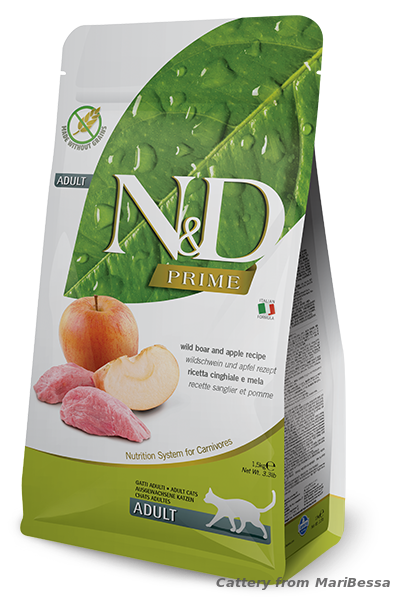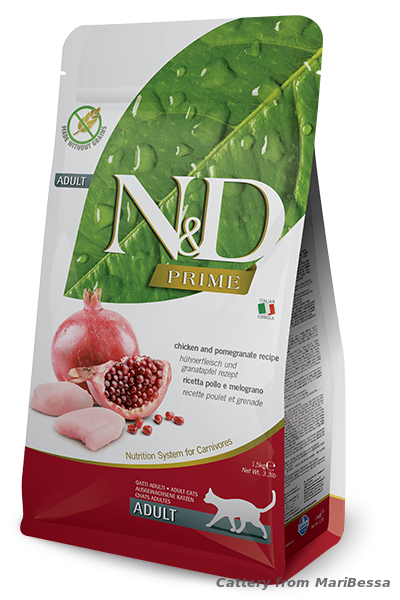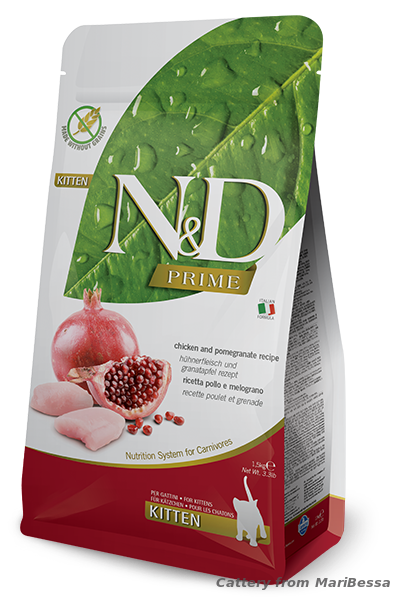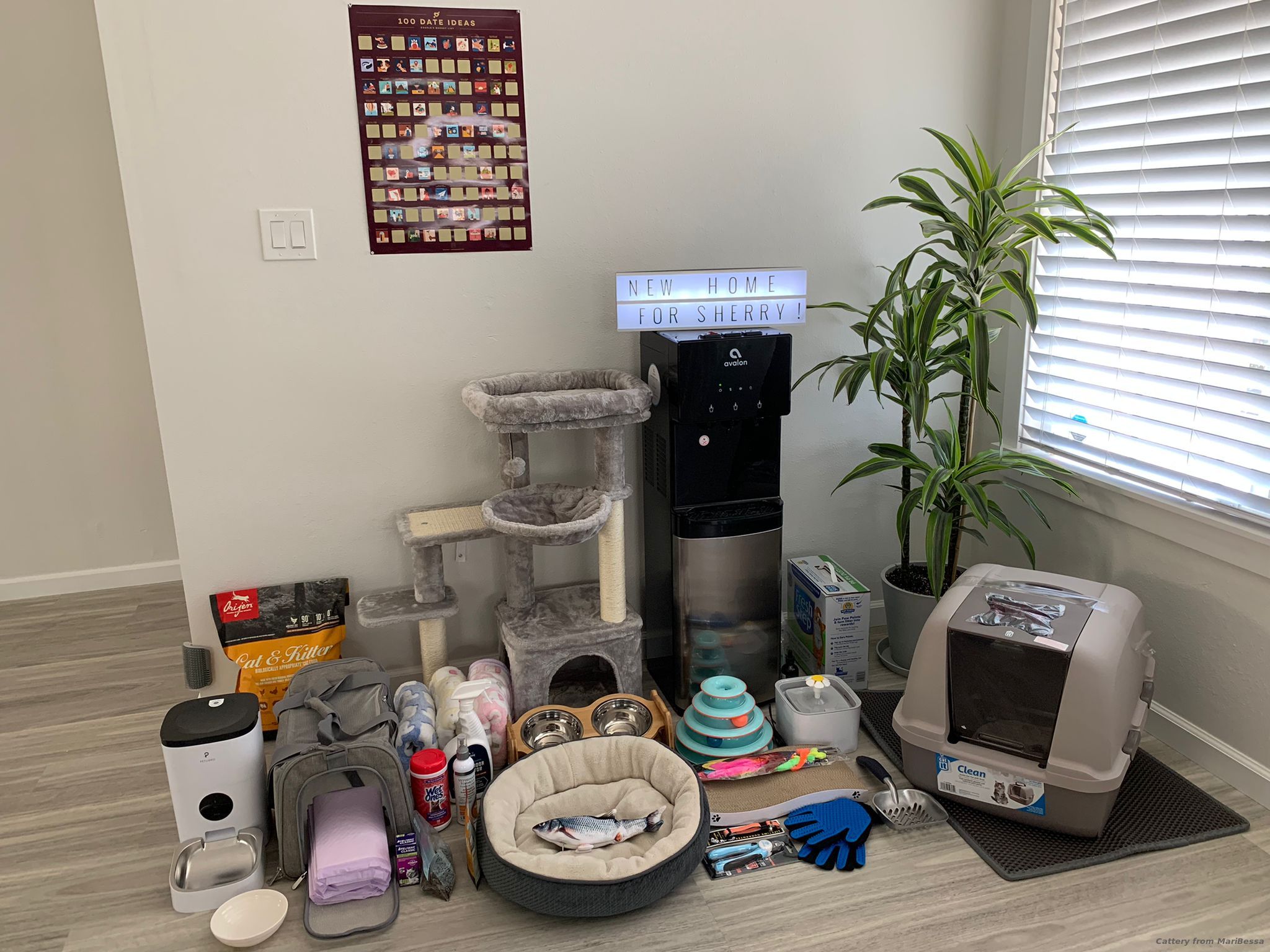Feeding the kitten
Almost all animals of our cattery eat only industrial professional feed, and only some of them prefer also natural products. When choosing food for your pet, you should take into account his preferences, as well as his habits. Of course, you should not go on about if your pet begs for foods that are contraindicated or harmful to him. Try to make your pet's food varied, offer him a variety of healthy foods to try. Sometimes cats become lovers of the most unusual foods, such as bananas, persimmons, tomatoes. These products will not harm your cat, and a small amount can be offered to your pet as a treat.
Eating a cat with industrial feed
We recommend feeding British kittens and cats with super premium industrial food. Not so long ago we discovered new professional cat food of the "Farmina" trademark (Italy), which we recommend for your pets.
The Natural & Delicious (N&D) line is recommended to provide a nutritious diet for British cats and kittens. These diets are of two types: grain-free (with a green leaf on the pack) and low-grain (yellow leaf). In the production of these feeds, natural ingredients, minerals, vitamins are used to create a balanced diet at an optimal price. The products are made from Italian raw materials. Farmina manufactures its products at three of its own factories, which are located in the following countries: Italy, Brazil, Serbia.
Animals fed with professional dry food should not be given any additional additives, as these feeds already contain all the necessary vitamins, minerals and amino acids.
Of course, you can use any professional feed of a class, but they must be at least premium. The new feed should be introduced gradually, adding a small amount to the usual feed.
Dry food for animals should always be freely available, then they will not eat "in reserve" and will not overeat.




How to care for a kitten or cat
There are a number of factors that contribute to a cat's well-being. If you take these factors into account from the very first day of your pet's stay in your home, you can create the necessary conditions for a healthy life and successful adaptation of your pet to its new environment.
Important aspects
For the appearance of a cat in the house, you need to prepare everything you need. We suggest that you familiarize yourself with the list of basic items necessary for a cat, and the requirements for the conditions of its maintenance. Lounger. This is a comfortable place to sleep, where the kitten or cat will feel comfortable and safe. It is recommended to place the bed higher, preferably in a quiet, safe place for the kitten, away from drafts. Tray. It should be deep enough, but not too deep, as high walls can scare the kitten away. You will also need a scoop to remove the excrement. Water bowls. The cat should always have access to fresh water. Fountains can be used as an alternative to bowls, as cats are known to enjoy watching water flow. This attracts their attention and encourages them to drink water. Food bowls. You will need a small food bowl. It must be installed at a sufficient distance from the water bowl to avoid contamination of the water. In addition, you can use the "food puzzles". They are especially suitable for indoor cats. Such a feeder will be an excellent stimulus for the development of mental abilities, a source of physical activity and a means for revealing the natural hunting instinct of an animal. It is necessary to give the cat time to get used to such a feeder, so do not immediately completely replace the “puzzle” with the food bowl. Game complex for cats. This additional purchase is not just entertainment. It also has a number of useful functions, as it allows the cat to sharpen its claws, climb and hide in a shelter, and also contributes to the well-being of the animal and the realization of its natural instincts. It is recommended to purchase several play complexes for cats and install them in different places of the house so that the cat can find a quiet corner away from guests and loud noise, where, if necessary, it can hide from prying eyes.
Environment
The environment is very important to a cat's health and well-being. A supportive environment allows the cat to socialize safely and get used to the people and things around it. Even if the cat is still very small, it will organize its territory and mark its boundaries. In this territory, the animal will sleep, play, hunt, eat, hide, climb and communicate with people. A cat “divides” its space into four different zones, and you must respect its choices to avoid behavioral problems, especially in indoor cats. Feeding area. It should be set up in a quiet location, away from the litter box and your own eating area. It is better not to use a dining room or places where the animal can be disturbed for these purposes. In addition, the feeding area should be large enough. Rest zone. This location will change throughout the day depending on sunlight exposure and the location of heat sources. By their very nature, cats tend to sleep high and must choose their own resting place, so make sure there are enough free corners in the house for your pet to enjoy. Sanitary area. The litter box should be installed in a quiet and always accessible place for the cat, away from its food bowl and areas of active movement of family members. Try to eliminate any sources of stress for your cat - for example, the pet may stop using the litter box if there is a washing machine next to it. It is recommended to provide each cat with at least one litter box, and install one additional litter box so that each pet has a choice to avoid cleanliness problems. Game Zone. This is the largest resting area for a cat. It is very useful to install a play complex for cats in this area: this will help the cat to be physically active, maintain its health and well-being.
Physical activity
Cats that are constantly kept indoors need regular physical activity: this will not only keep them fit, but also have a stimulating effect on mental functions. This means that cats need the following. A large number of toys (they can be periodically hidden and replaced with others to keep the cat interested), a place to climb and hide, as well as regular daily games with your family members. Because indoor cats are more likely to lick their fur and are sedentary, they need nutrition that will help them cope with hairball (especially important in long-haired breeds) and take into account their low activity levels. You are unlikely to like the scratches your cat can leave on furniture or walls. However, this is a natural behavior of the cat, so it is important to provide her with special places where she can sharpen her claws. Install at least one scratching post in your home.
Feeding
For domestic cats, effective feed intake depends on several factors. Cats that are constantly kept indoors need regular physical activity: this will not only keep them fit, but also have a stimulating effect on mental functions. Only high quality food, specially formulated for cats, can guarantee that they receive all the nutrients they need to maintain their health, regardless of their age, breed, lifestyle and health characteristics. While humans benefit from a varied diet, frequent and constant changes in a cat's diet negatively affect cat digestion. Food Puzzles are a great way to develop your cat's mental abilities, as well as encourage her to forage and show her hunting instincts. Hunting habits strongly influence the feeding behavior of cats, so they tend to eat small meals several times throughout the day, rather than eat the entire contents of the bowl in one or two meals a day. Cats have a very high need for protein, including essential amino acids, one of which is taurine, found only in animal products. Fat is an important source of energy for cats, which require more calories than the recommended calorie intake for humans. Cats also have special needs for vitamins and minerals, such as vitamin D, which they can only get from food. The digestive tract of a newborn kitten is well suited for the digestion of milk, as long as the milk meets the needs of the kittens. But with age, the ability to digest will change, and by the time a cat is an adult, its body will no longer be able to metabolize lactose.
Hair care
In addition to the fact that a well-groomed, combed coat looks beautiful, it contains fewer dead hairs that the cat can swallow while grooming, and she spends an average of 30% of her time doing this. The dead hairs then enter the cat's digestive system, where they can cause hair clumps and digestive problems. For short-haired and smooth-haired cats (British Shorthair breed), sometimes it is enough to confidently run your hand over the coat several times, pressing the palm tightly to the animal's body.
Health
The health and well-being of a cat depends on a number of factors, from preventive vaccinations and medications to health insurance and even neutering. All this comes with certain costs. Some of these costs are one-off costs, while others need to be considered as part of the current animal budget, along with food and grooming costs. Cats are vaccinated against feline panleukopenia virus, feline herpesvirus and feline calicivirus. All our cats have already had all injections since about nine weeks of age. It is important to carry out preventive treatments against fleas, ticks and worms. In our nursery, we begin to carry out antiparasitic treatment from an early age. To prevent disease and to be able to track changes in your pet's weight and behavior, it is important to show it to your veterinarian every year.
Upbringing
Much of a kitten's training takes place during the first six months of life. Thanks to the dominant role of the mother and interaction with other kittens, the main part of the cat's future behavior pattern is laid in the first three months of life. Consequently, once a kitten is in your home, your options to contribute to the basics of its education are limited, but you still have a number of responsibilities in raising the animal. Your task is to complete the education of your pet in the context of the new environment and eliminate its unwanted behavior.

How much do kittens cost, and what does the price depend on?
• Why is the price of each kitten different and subject to change?
Often, kittens are offered for reservation when they are still very young, and in this case their price is determined based on either color, or blood, or the development of kittens from previous litters.
Later, as the kittens grow and develop, the price may change up or down (after the reservation and the conclusion of the contract, the price does not change anymore).
What does the price depend on? The price depends on very, very many things: first of all, it is the type of animal, its quality, blood, color, purpose of purchase, supply and demand, the wishes of the breeder himself. in more detail:
• the type of animal is the main thing that determines the price! The more extreme the type of animal, and for the British it is a large head with small ears, rounded eyes, a good profile and vibrissae, a powerful semi-cobby physique, and a short tail.
It is on the type of animal that the breeding work of breeders is directed, in which achievements are highly valued. The breeder often spends several years of work to obtain the desired type of his animals, achieving the desired result by selecting certain pairs of producers, each time leaving the animals necessary for his work or acquiring them in other nurseries. This is a difficult and painstaking job, where the result is often unpredictable and depends on luck.
This does not mean that animals that are not extreme in type are less beautiful, or less purebred. There are no clear boundaries between animals of different types.
• quality - regardless of their type, animals can be of different qualities. For example, they may have defects that exclude breeding use, but do not in any way affect their quality of life. These animals can be cheaper. But not always the presence of defects that exclude breeding (breeding) can greatly reduce the price of a kitten. If this is a beautiful animal of an extreme type, then its price may be even higher than the price of a kitten without defects, but very average in type.
• color - the price depends on the color, for example, all colors in our kennel are rare at the moment and some are just very popular. Also, the price depends on the quality of the color.
• blood - the purchase of animals of a certain blood, it may be interesting if you plan to engage in breeding work. Kittens from some manufacturers may cost more than others. For example, because these bloods are either very rare, or kittens from these producers have had the greatest success at shows.
• Purpose of purchase - the price may depend on the purpose of your purchase. Do you want a kitten just for the house as a pet, or do you expect to be able to get kittens from your pet in the future? Depending on the purpose of the purchase, the same kitten can have two prices: "with the right of breeding" and "without the right, like pet", neutered, but in this case the pedigree can also be issued (even free).
• supply and demand - this also affects the price. Some animals, for example, lilac color, type or blood, may be in high demand, or may simply be rare at the moment in the supply.
• the wish of the breeder himself - each breeder himself determines the prices for his kittens, based on personal considerations.

What is considered not a standard (marriage)?
If the goal of breeding is not worth it, then the presence of a marriage in a kitten should not scare you much, since this does not in any way affect the quality of his life.
• tail misalignment - not perfectly straight tail. It can be of varying degrees of severity, from minimal, when nothing is visually visible, to the so-called "creases" and "hooks". The presence of this defect does not prevent the kitten from living, but the rules do not allow the use of such animals in breeding. Participation in exhibitions in the Castrat class is possible.
• squint - excludes the breeding use of the animal, but for some owners it is just a cute feature of their pet.
• color defect - the presence of small white spots or medallions in the color. Usually they are located on the chest or abdomen, in the groin. It is quite rare.
• cryptorchidism - undescendedness of one or both testes (testicles), it happens, respectively, only in male. Up to 10 months of age is not considered a marriage.
Animals with marriage are not always in the offer. The presence of a marriage does not necessarily reduce the price very much. If this is a beautiful animal of an extreme type, then its price may be even higher than the price of a kitten without defects, but very average in type.
All the other traits that seem imperfect to you in any particular animal are not a marriage, but just a flaw. And all animals have "flaws", even the most titled super-mega-stars. There is no limit to perfection!
